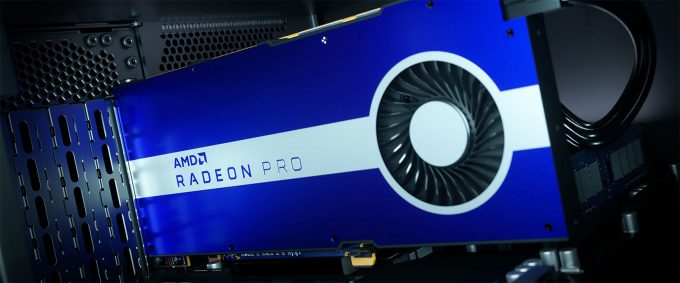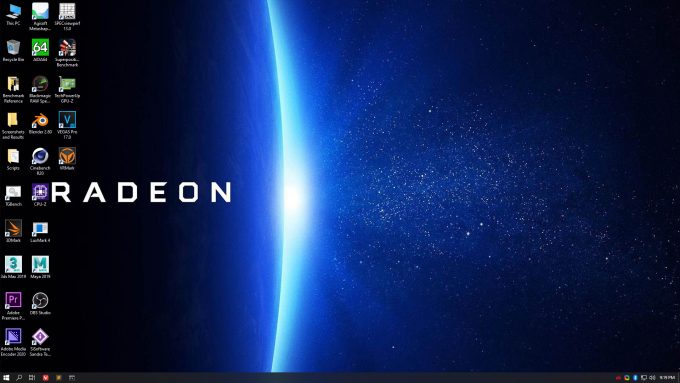- Qualcomm Launches Snapdragon 4 Gen 2 Mobile Platform
- AMD Launches Ryzen PRO 7000 Series Mobile & Desktop Platform
- Intel Launches Sleek Single-Slot Arc Pro A60 Workstation Graphics Card
- NVIDIA Announces Latest Ada Lovelace Additions: GeForce RTX 4060 Ti & RTX 4060
- Maxon Redshift With AMD Radeon GPU Rendering Support Now Available
Mid-range Pro Navi: AMD Radeon Pro W5500 Workstation Graphics Card Review

AMD released its Navi-based Radeon Pro W5500 a few months ago, and to say we’ve spent a lot of time battering it with tests would be an understatement. We’re taking a look at AMD’s latest $399 professional GPU with the help of many encoding, rendering, viewport, and gaming tasks.
Page 1 – Introduction & Testing References
Since late 2016 when we saw AMD transition its workstation graphics series from FirePro to Radeon Pro, the boldly blue cards have spanned three architecture generations. The first out-of-the-gate were the Polaris 4th-gen GCN cards, which were quickly joined by the 5th-gen GCN Vega cards. With the launch of the W5700 in November, RDNA 1.0 became the newest hotness.
It’s an interesting time for AMD workstation graphics, because depending on the workload, either Navi or Vega could be the better choice. For most ProViz use, Navi is a safe bet, especially since it has the latest (and best) version of AMD’s encoder. For those with hungrier data crunching needs, or want the absolutely best performance AMD offers, Vega remains a solid choice. We’ve seen proof with the recent launch of the Radeon Pro VII that AMD is keeping to its word that Vega’s life will continue on.
With its 1,408 cores, the W5500’s specs closely align with the Radeon RX 5500 XT from the gaming side, whereas the W5700 we’ve taken a look at before has closely matched the RX 5700 (non-XT). That means AMD still has a bit of room to later release a W5600 that would likely inherit the 2,304 cores of the RX 5600. The W5700 has fewer cores than the RX 5700 XT, so the company even has room to release another top-end Navi beast later. Or, it could become that our speculations are wrong (as usual).
What we do know for sure is that the W5500 we’re taking a look at here is AMD’s second released Navi card. Thankfully, the fact that AMD just released a new Radeon Pro VII doesn’t impact our performance look here, as the $1,500 delta in the prices of those cards may suggest.
| AMD’s Radeon Pro Workstation GPU Lineup | |||||||
| Cores | Base MHz | Peak FP32 | Memory | Bandwidth | TDP | Price | |
| Pro VII | 3840 | ??? | 13.1 TFLOPS | 16 GB 8 | 1TB/s | 250W | $1899 |
| W5700 | 2304 | 1183 | 8.89 TFLOPS | 8 GB 1 | 484 GB/s | 205W | $799 |
| W5500 | 1408 | 1200 | 5.35 TFLOPS | 8 GB 1 | 224 GB/s | 125W | $399 |
| WX 9100 | 4096 | 1200 | 12.3 TFLOPS | 16 GB 8 | 484 GB/s | 230W | $1399 |
| WX 8200 | 3584 | 1200 | 10.8 TFLOPS | 8 GB 8 | 512 GB/s | 230W | $999 |
| WX 7100 | 2304 | 1188 | 5.73 TFLOPS | 8 GB 3 | 224 GB/s | 130W | $549 |
| WX 5100 | 1792 | 713 | 3.89 TFLOPS | 8 GB 3 | 160 GB/s | 75W | $359 |
| WX 4100 | 1024 | 1125 | 2.46 TFLOPS | 4 GB 3 | 96 GB/s | 50W | $259 |
| WX 3200 | 640 | 1295 | 1.66 TFLOPS | 4 GB 3 | 96 GB/s | 50W | $199 |
| WX 3100 | 512 | 925 | 1.25 TFLOPS | 4 GB 3 | 96 GB/s | 50W | $169 |
| WX 2100 | 512 | 925 | 1.25 TFLOPS | 2 GB 3 | 56 GB/s | 50W | $129 |
| Notes | 1 GDDR6; 2 GDDR5X; 3 GDDR5; 4 HBM2 5 GDDR6 (ECC); 6 GDDR5X (ECC); 7 GDDR5 (ECC); 8 HBM2 (ECC) Polaris 4th-gen GCN = WX 2100~7100 Vega 5th-gen GCN = WX 8200~9100 & Pro VII Navi RDNA 1.0 = W5500~5700 |
||||||
In terms of quoted single-precision performance, the W5500 settles a little bit behind the older WX 7100. That technically means that the WX 7100 should win most tests, but it’s of course never that simple. AMD’s newer card will definitely be able to show off its strengths throughout our performance results.
And with that, this card is pretty easy to gauge based on its specs, so we can get right into a quick look at our test setup, and then move into the results.
Test PC & What We Test
On the following pages, the results of our workstation GPU test gauntlet will be seen. The tests chosen cover a wide range of scenarios, from rendering to compute, and includes the use of both synthetic benchmarks and tests with real-world applications from the likes of Adobe and Autodesk.
To paint a good overall picture of current performance, we’re using a blend of gaming and workstation GPUs. For some users, the best performance for the buck is the most important factor when scouting out a new GPU, while for others, increased platform stability and optimization through drivers is more integral.
Across these tested GPUs, price ranges of $200~$900 are covered. That means we’re missing out on some higher-end results, but for the purpose of taking a sufficient look at a $400 GPU, those cards weren’t necessary for this review. We do however have additional cards being tested now, and will post a more general (but fuller) performance look in the weeks ahead.
| Techgage Workstation Test System | |
| Processor | Intel Core i9-10980XE (18-core; 3.4GHz) |
| Motherboard | ASUS ROG STRIX X299-E GAMING |
| Memory | G.SKILL FlareX (F4-3200C14-8GFX) 4x8GB; DDR4-3200 14-14-14 |
| Graphics | AMD Radeon Pro W5700 (8GB, Enterprise 20.Q1.1) AMD Radeon Pro W5500 (8GB, Enterprise 20.Q1.1) AMD Radeon Pro WX 7100 (8GB, Enterprise 20.Q1.1) AMD Radeon Pro WX 4100 (8GB, Enterprise 20.Q1.1) AMD Radeon RX 5700 XT (8GB, Adrenaline 20.4.1) AMD Radeon RX 5600 XT (8GB, Adrenaline 20.4.1) NVIDIA Quadro RTX 4000 (8GB, Quadro 442.92) NVIDIA Quadro P2200 (5GB, Quadro 442.92) NVIDIA GeForce RTX 2060S (8GB, Studio 442.92) NVIDIA GeForce RTX 2060 (8GB, Studio 442.92) NVIDIA GeForce GTX 1660 Ti (8GB, Studio 442.92) |
| Audio | Onboard |
| Storage | AMD: Samsung 480GB SATA SSD NVIDIA: Samsung 480GB SATA SSD |
| Power Supply | Corsair 80 Plus Gold AX1200 |
| Chassis | Corsair Carbide 600C Inverted Full-Tower |
| Cooling | NZXT Kraken X62 AIO Liquid Cooler |
| Et cetera | Windows 10 Pro build 18363 (1909) |
Our benchmark results are categorized and spread across the following pages. On page 2, we’re taking a look at renderers with the help of Blender and LuxMark. Page 3 is home to our encoding tests, which are handled by Adobe’s Premiere Pro, MAGIX’s Vegas Pro, BRAW Speed Test, and an application we throw into the same pile: Agisoft’s photogrammetry tool, Metashape. Page 4 handles viewport performance across a range of popular suites, and page 5 tackles some simple gaming. The final page will include some power tests along with our final thoughts.
And with all of that covered, let’s get on with it:
Support our efforts! With ad revenue at an all-time low for written websites, we're relying more than ever on reader support to help us continue putting so much effort into this type of content. You can support us by becoming a Patron, or by using our Amazon shopping affiliate links listed through our articles. Thanks for your support!







